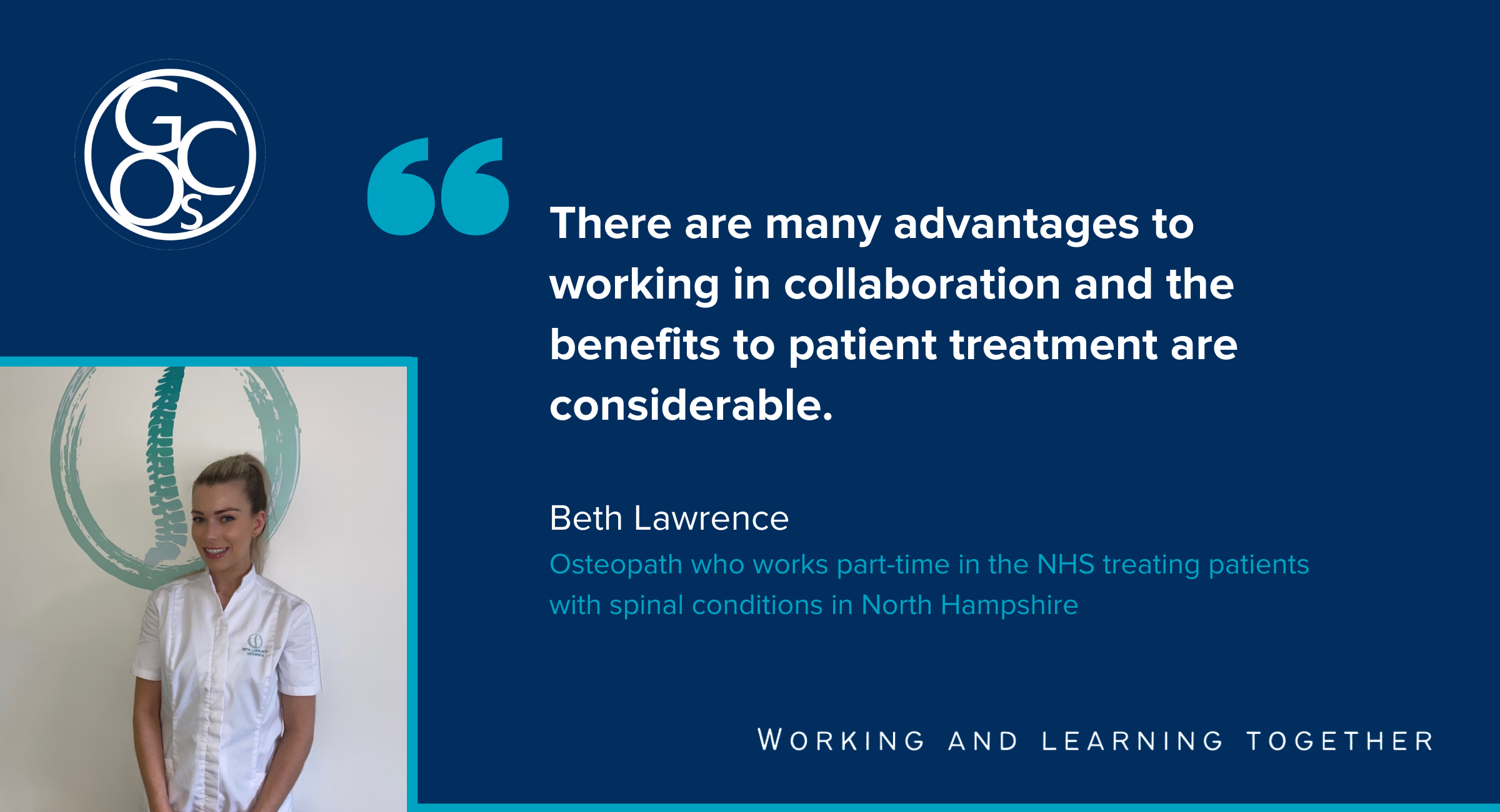I believe there is huge benefit to working alongside other health care professionals in order to provide a multi-disciplinary approach
12 November 2021
Osteopath Beth Lawrence shares her experiences of working with other healthcare professionals to provide the highest standards of patient care.
I was fortunate to begin my career as an osteopath working in a multi-disciplinary service, Circle Integrated Care MSK Service in North Hampshire. Since qualifying in 2019 the support and advice I have received from other healthcare professionals has been invaluable, it has become second nature to me to collaborate with other practitioners to provide the highest standards of patient care.
Right from the start I felt I really benefited from the Clinical Director’s 30 years of experience treating patients. Working together and supporting the Clinical Director, a registered chiropractor, we were responsible for assessing GP referrals and putting patients in front of the clinician we felt most likely to provide the most appropriate treatment. We would undertake an initial assessment and write a Care Plan, outlining the patient’s diagnosis and treatment, then we would share this with the patient’s GP and across the service for continuity and integration of care.
I have gained skills during my time at Circle that are essential for all healthcare professionals such as an understanding of the importance of talking with patients to establish their expectations and about how to actually communicate with patients. Being able to manage these conversations in order to deliver the best outcome for the patient is critical.
Combining expertise to provide the best level of care
I am the only osteopath at Circle, and I work closely with the chiropractors and physiotherapists and value the support they provide. We regularly practise techniques together and share knowledge. We discuss patients and their treatment options, combining our expertise to provide the best level of care. This is particularly helpful for patients who have specific health conditions. I learn from the experience of other practitioners who have either treated patients with these conditions or recognise the symptoms and are able to provide insights into how the conditions might progress.
I have treated patients who weren’t presenting with severe symptoms, but an MRI scan showed a severe condition. As I have only been qualified for a couple of years, it can be daunting to treat patients with a severe condition, but talking with experienced practitioners from a variety of disciplines gives me direction and peace of mind that I am providing the most appropriate care to the patients.
Patient feedback
If a patient requires further treatment, I make a referral through the triage system to a surgeon or consultant and suggest an MRI. It’s important to get the language right when writing a referral to another healthcare professional. I always respectfully ‘suggest’ an approach to treating a patient rather than dictating. In my experience surgeons are open to working with osteopaths and they have been happy to accept my judgement. Working with us and accepting our advice can be beneficial and helps manage their waiting lists.
One of the most invaluable aspects of working in a multi-disciplinary service are the shared training opportunities. As part of our CPD we have monthly Zoom calls on important topics such as pain management and treating chronic pain. This is another channel through which we can share experiences and conversations with patients, ensuring we continue to provide the highest standards of patient care.
Patients respond very well to the integrated service. Feedback from patients, collected via an automated feedback form, has been extremely positive, with over 98% of patients happy with their care and almost three-quarters of patients saying the care exceeded their expectations.
Developing new relationships
While the clinic was temporarily closed for seven months in March 2020 due to COVID-19, I took the opportunity to open my own practice which I now run alongside my existing NHS commitments. I am exploring ways to build the business which includes taking a proactive approach to developing relationships with local healthcare professionals. For example, I’ve linked with personal trainers at the local leisure centre to develop a tailored referral programme to help patients with sports injuries.
I have also written letters to local GPs but so far I’ve found that few are receptive. In my experience, many GP pathways focus on referring patients to physiotherapists with osteopathy considered as an alternative therapy. Being an Allied Health Professional is helpful and has increased acceptance of osteopathy across the NHS but this is still a work in progress in practice.
It is my long-term plan to expand the clinic to become a multi-disciplinary practice.

There are many advantages to working in collaboration and the benefits to patient treatment are considerable. When we, as healthcare professionals, think only our profession can help a patient then we are not providing the most effective care.
About Beth
Beth Lawrence graduated from the University College of Osteopathy, formerly the British School of Osteopathy, in 2019, with a Masters Degree in Osteopathy after 5 years of training. Beth recently opened her own practice, Osteobeth in October 2020, and also works part-time in the NHS treating patients with spinal conditions in North Hampshire.




